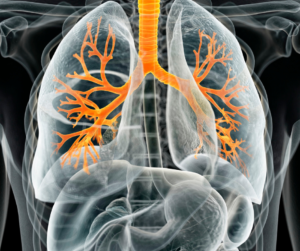When you inhale, air enters your lungs, and oxygen from the air moves from your lungs to your blood.
At the same time, carbon dioxide moves from your blood to the lungs and is exhaled. There we have it, gaseous exchange = Life.
But what about when you’re running… the same process right?
But why do we find ourselves huffing and puffing not even 1km into our runs?
Research shows that the best way to breathe while running is to take deeper, longer breaths and to include rhythmic breathing. Runners should aim to keep their breathing as controlled as possible for as long as possible, to do this they should take walk breaks before they reach the point of uncontrollable panting.

It is in any runner’s best interest to focus on their breathing. By breathing properly, runners can maximize their performance, boost running ease and efficiency so that they can run to their full potential.
So… how do we do it?
Breathing While Running
The best way to breathe is to undoubtedly have longer deeper breaths, combined with rhythmic breathing.
Most people’s breathing rates adjust to the energy demand, so the fitter you are, the more efficient that process becomes.
When you are running one of your harder runs, your respiratory rates (breathing in and out) will increase substantially, but there shouldn’t be any panting. Your breaths should still be big and you should be clearing out most of the capacity of your lungs so that you can take another deep breath in.
The problem (particularly with less trained athletes) is that when they start getting to that point of increased respiratory rates… They start to pant – Shallow, rapid breathing.
Shallow rapid breathing is inefficient because you won’t be getting rid of enough carbon dioxide and you won’t be inhaling enough oxygen. This is when you would quickly start to feel quite tired, resulting in stitches.

How To Breathe Properly While Running
To breathe properly while running you should take deep breaths at a rate determined by the demand for oxygen in your body.
To achieve this, slow your breathing down by actually slowing down your run. Your first goal should be to achieve that deep rhythmic breathing. It’s important to remember that even if you are breathing rapidly but taking deep rapid breaths then that’s alright. As long as you make sure those breaths are deep.
We recommend the run/walk strategy so that you can run faster for longer while breathing properly.
The run/walk strategy applies because you don’t want to run yourself to the point of not being able to breathe properly so you end up panting and having to walk.
One mistake we see runners often making is when they reach a hill on their route, they choose to run up that hill until they literally can’t anymore, thinking their legs are failing but more often than not, it is the fact that they can’t get enough air. They are forced to walk.
By taking regular walk breaks you can stop yourself from getting anywhere near that respiratory distress.
The Talk Test

We like to call this breathing strategy for running the “Talk Test”. If you are still able to hold a conversation while running, then your breathing is under control as opposed to the good ole’… TalkAsFastAsWeCan…GASP FOR AIR…TalkAsFastAsWeCan method.
Obviously, if you are racing 5km, 10km & 15km races then holding a conversation isn’t going to work but for training runs and long distances then a good way to tell if you are running easy enough and breathing properly is to hold a conversation.
Belly Breathing While Running
As we mentioned above, deep breathing or belly breathing is what will increase the flow of oxygen-rich blood to your muscles.
Did you know that breathing deeply also has other amazing effects on your body?
Based on this study, belly breathing improves your focus and has a calming effect, which will improve your mental strength.
Now that we know how to breathe properly while running, let’s take a look at what benefits we gain from breathing correctly…

Benefits Of Breathing Properly While You Run
- Helps you perform at your maximum potential.
- Helps your muscles get the oxygen they need to keep going.
- Activates your core.
- Helps you maintain a steady running pace.
- Help your muscles produce less carbon dioxide
- Improve blood circulation and heart health
We know that our bodies will alter our breathing patterns, in response to changes in our activity levels, but some of us have those breathing habits that may be affecting our running abilities…
Nose or Mouth Breathing While Running
There is really no straightforward answer…
If you’re heading out for a slow, short distance run then inhaling & exhaling through your nose is perfect. As your pace increases, your body will need more oxygen. This is when mouth breathing kicks in to help out. A lot of people choose to inhale through their noses and exhale through their mouths.
If You find yourself struggling to catch your breath and do the talk test. Then it would suit you to inhale and exhale through your mouth.
During high-intensity runs and races, it’s recommended to breathe through your mouth only, as it’s more efficient because it allows more oxygen to enter your body and fuel your muscles.
Whether it’s through your nose or mouth, what is most important is that those breaths are deep and controlled. Once you are used to breathing this way while running, you can start working on your rhythmic breathing.

Rhythmic Breathing While Running
By rhythm, we are referring to how many steps you take during your inhale compared to how many you take during your exhale.
An example: if you take 2 steps whilst breathing in and then 2 steps whilst breathing out, your breathing rhythm is 2:2.
Breathing in a rhythmic pattern allows you to take in more oxygen and put less stress on your body.
Research suggests for a normal, easy run following a 3:2 pattern – (Inhale for three) (Exhale for two), and for a faster run following a 2:1 pattern.
In our opinion, If following a running pattern feels too complicated, it’s perfectly okay. All you need to do is pay attention to your breath to get a sense of how a comfortable rhythm feels. You’ll get the hang of it!

Struggling To Breathe While You Run?
As you know, running is an aerobic exercise, meaning your body needs large amounts of oxygen to do the activity.
This can result in you gasping for air – which is normal… And can be managed with the breathing strategies we spoke about above.
By slowing down, taking deeper, controlled, and longer breathes we can control our “panting” and the oxygen demand should be met = normal breathing.
If your breathing does not improve then we suggest consulting your doctor as it could be a sign of an underlying health condition.
How To Stop Shortness Of Breath While Running:
- Slow down
- Breathe deeply into your core
- Use your nose & mouth
- Remove your headphones (Be in touch with your breath)
- Correct your posture (Straight back & shoulders back)
Check out this video where Coach Lindsey Parry and Brad Brown team up once again to discuss the most efficient way to breathe whilst running: Here




Comments are closed.